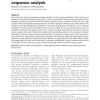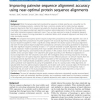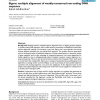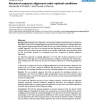146 search results - page 2 / 30 » Segment-Based Scores for Pairwise and Multiple Sequence Alig... |
BIB
2006
13 years 4 months ago
2006
One of the major goals of computational sequence analysis is to find sequence similarities, which could serve as evidence of structural and functional conservation, as well as of ...
BMCBI
2010
13 years 4 months ago
2010
Background: While the pairwise alignments produced by sequence similarity searches are a powerful tool for identifying homologous proteins - proteins that share a common ancestor ...
BMCBI
2006
13 years 4 months ago
2006
Background: Existing tools for multiple-sequence alignment focus on aligning protein sequence or protein-coding DNA sequence, and are often based on extensions to Needleman-Wunsch...
BMCBI
2005
13 years 4 months ago
2005
Background: Multiple genome alignment is an important problem in bioinformatics. An important subproblem used by many multiple alignment approaches is that of aligning two multipl...
CANDC
2005
ACM
13 years 4 months ago
2005
ACM
We propose an algorithm of global multiple sequence alignment that is based on a measure of what we call information discrepancy. The algorithm follows a progressive alignment ite...




